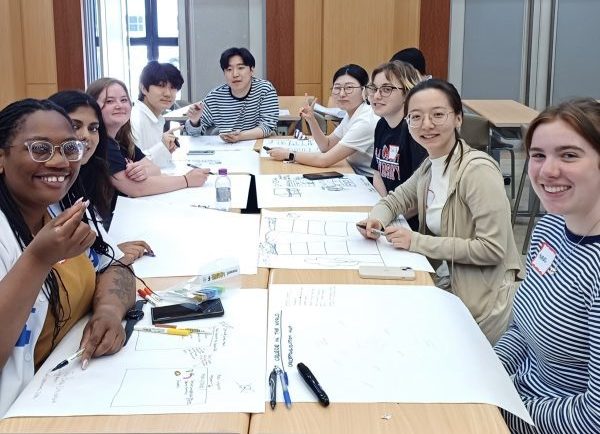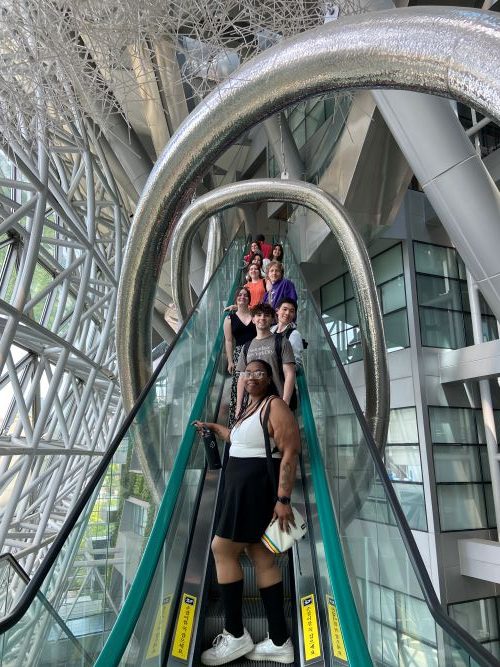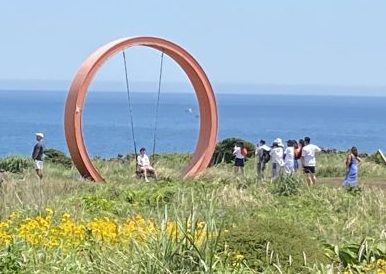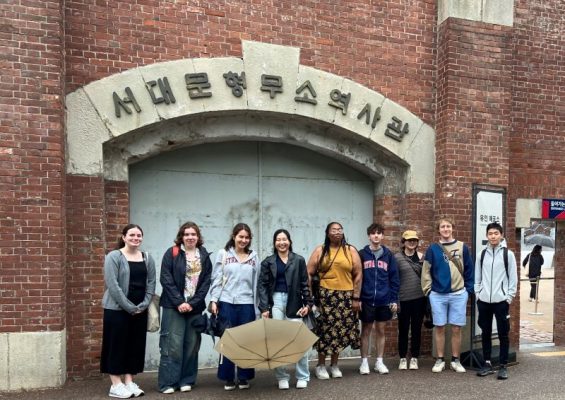Students pose at Nakchunsa, a temple on Jeju Island. The structure is one of the tallest Buddhist temples in Asia. In Jeju, Dolharubang statues are positioned at entrances to residences and cities because they are thought to be protectors.
A group of students recently explored the city of Seoul, South Korea, to learn about the country’s historical and contemporary sites and to see how its unique culture and traditions have affected its natural and built environments.
The two-week excursion was led by Seyeon Lee, associate professor of environmental and interior design and George Miller quasi-endowed professor in the College of Visual and Performing Arts. Nine undergraduate students from a variety of majors accompanied Lee for the new Maymester study abroad course to learn how social issues and various design practices have shaped the country’s landscapes, cities and structures.

The workshop at Yonsei University focused on creating designs that are diverse, equitable, inclusive and accessible. (Photo by Seyeon Lee)
The course emphasized the concept of how every space is shaped by its environment and community, apart from design and architectural considerations. Students explored a number of major historic and modern sites in a timeline that followed significant chronological events, from Chosun Dynasty structures to futuristic buildings incorporating high-tech communication and travel modes. They explored Seodaemun Prison Hall from the Japanese colonial era and visited the Demilitarized Zone at the border between North and South Korea to understand how political issues and historical events affect society. A side trip to Jeju, a remote island, offered a perspective of the land as a UNESCO Global Geopark within the county’s unique rural environment. A global geopark uses geological heritage and other aspects of an area’s natural and cultural heritage to increase understanding of key social issues.
The group joined 32 other students from Ball State University in Indiana and Yonsei University’s College of Human Ecology in Seoul for a workshop on the importance of building campus environments that are diverse, equitable and inclusive. In addition to Lee, who also serves as the VPA’s associate dean for diversity, equity, inclusion and accessibility, students worked with three other faculty members. They were Yongsei’s Suk-Kyung Kim, dean of the College of Human Ecology; and Ball State’s Sanglim Yoo, associate professor of urban planning and Juntae Jake Son, assistant professor of interior design.

Seoul City Hall Seoul City Hall was built as a sustainable and high-efficiency structure having the largest green wall in the world, as well as geothermal and photovoltaic systems, a rooftop garden and many more amenities for citizens to enjoy, including this futuristic-design escalator. (Photo by Seyeon Lee)
The course is an exploratory one, Lee says, and it was designed in keeping with the University’s goal that all students have opportunities to enjoy a study away or study abroad experience, even one of short duration.
“The goal of this Maymester course, apart from instructing on design content, is to immerse students in the local culture and allow them to experience the intricacies of daily life and the traditions of South Korea. We feel this program enriches student’s overall academic experience and fosters a deeper understanding of the global contexts of their educational journey,” Lee says.
“For instance, when the students visited Seodaemun Prison Hall, they learned how the building represents the Japanese Colonial era and how the Korean people fought for their independence then. The building is a museum now and its exhibitions represent a similar historic presence in Korea the way the Auschwitz concentration camp site does in Germany,” Lee says. “Rather than focusing only on design concepts or elements of the buildings or sites visited, Lee says the group concentrated on cultural and historic aspects of the places they visited and how those components shaped the spaces over time.”
Students who toured the country for the two-week Maymester course were enthusiastic about the experience.
Adam Drafts-Johnson ’25, a design studies major, says the two-week format provided a study abroad alternative that allowed him to complete his major on time. “Korea offered a place that was unfamiliar and where I wouldn’t be in the majority. This class helped me understand the vastness of world cultures and appreciate lifestyles having values not common where I am from. The daily journaling allowed me to focus on my sketching and storytelling skills.”
Leondra Tyler ’24, who will graduate in December with dual degrees in neuroscience and psychology, was previously an exchange student at Yonsei University, so the class allowed her to engage with Korean culture again. “I love learning about social behavior and culture, and this class granted me a unique way to explore that,” she says. “As a STEM major, I felt like this class was inclusive to all majors. I learned a lot about how culture and conflict shape the design of buildings and art.”

This picturesque scenic is located at a cape on the east end of Jeju Island. The ring with a swing is a tourist attraction designed to be a popular photo-taking spot. (Photo by Seyeon Lee)
Holly Ishiro Randall ‘26, an environmental and interior design major, had never studied abroad before, so the course gave her an opportunity to be immersed in a new culture and country. “My experiences navigating through South Korea and interacting with the people there were incredibly valuable. They expanded my depth and exposure to different design styles and aesthetics. This course has definitely introduced new ideas and inspiration for my future studies and projects.”
Keira Bowers ’27, a biology major in the College of Arts and Sciences, says she enjoyed seeing how a different culture incorporates science and technology into daily life. “It was so insightful to see all the eco-friendly practices and energy-saving devices South Korea has put in place and how they’ve been designed into building plans. And after a year of core curriculum courses, it was nice to take a class of my choosing that invites creative freedom in our coursework.”


